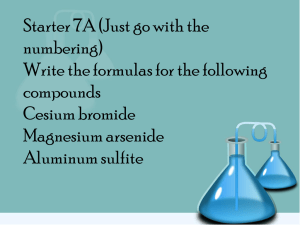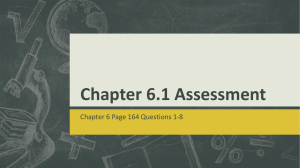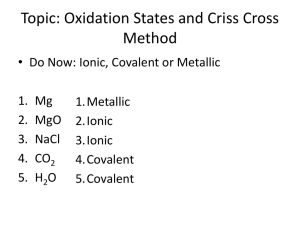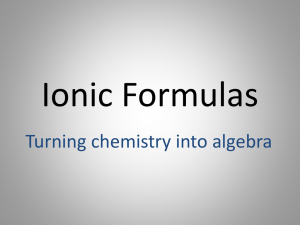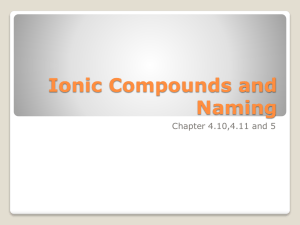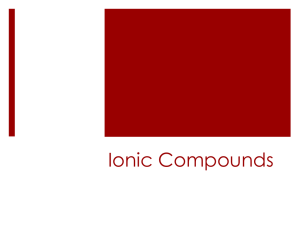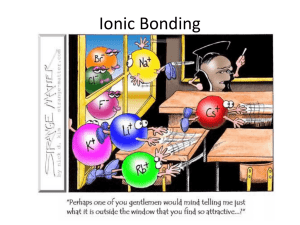Metallic bonds
advertisement
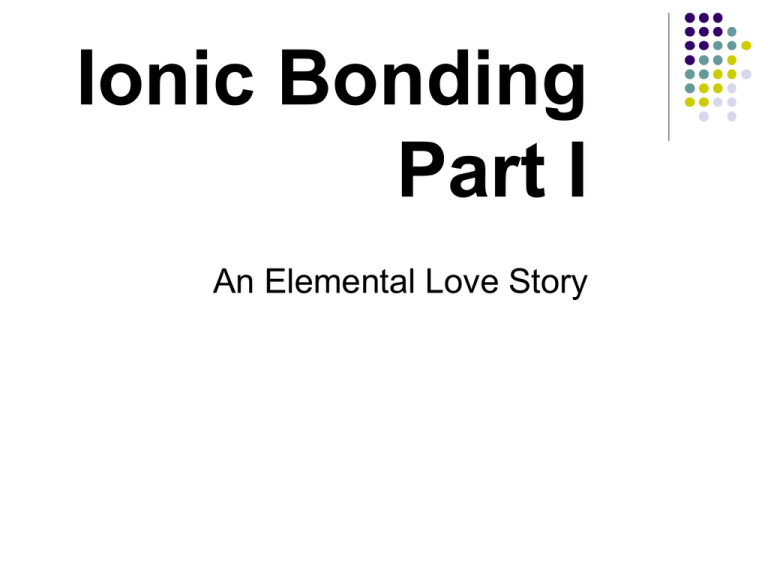
Ionic Bonding Part I An Elemental Love Story Demo Burning string demo Clean string vs Sugar soaked string vs Salt soaked string Any difference? Research Mission For this week, you will read articles about: Iodine deficiency disorder Pros and cons of fluoride The importance of potassium The dangers of chromium After gathering information, your group will present what you learned and how it relates to ions and ionic bonding. Before we dive in What is a chemical bond? What are three main different types of bonds? Why do elements form ions? What is a cation? What is an anion? Bonds Q: How do elements combine to form compounds? A: Compounds have different forces that hold groups of atoms together and make them function as a unit called bonds. Bonds Bonds come in three main varieties: 1. Metallic bonds – when metal cations bond they share a sea of delocalized electrons. 2. Ionic bonds – transfer of electrons between metals and non metals 3. Covalent bonds – sharing of electrons between two nonmetals Metallic Bonding Strong forces of attraction are responsible for the high melting point of most metals. Metallic Bonding The chemical bonding that results from the attraction between metal cations and the surrounding sea of electrons Vacant p and d orbitals in metal's outer energy levels overlap, and allow outer electrons to move freely throughout the metal Valence electrons do not belong to any one atom Properties of Metals Metals are good conductors of heat and electricity Metals are malleable Metals are ductile Metals have high tensile strength Metals have luster Metal Alloys Alloys: some metal atoms replaced by others of similar size. Ionic bonding Ionic compounds bond in repeating 3dimensional patterns with alternating positive and negative ions called crystal lattice. Ionic Crystal Lattice Shapes Ionic bonding All salts are ionic compounds and form crystals. NaCl forms the simplest cubic structure Properties of Ionic Compounds Structure: Melting point: Boiling Point: Electrical Conductivity: Solubility in water: Crystalline solids Generally high Generally high Excellent conductors, molten and aqueous Generally soluble Properties of Ionic Compounds Lab! We will be examining the properties of ionic compounds next double with a lab. In the meantime, we will move onto how and why ions bond. Great BBC video on ions http://www.bbc.co.uk/schools/gcsebitesize/sci ence/add_aqa_pre_2011/atomic/ionicact.sht ml Know our ions inside and out In order to be successful with ionic bonding, you need to know what ion each element in the s and p block will form. Practice on the Ion worksheet grid in the packet The Octet Rule – Ionic Compounds Ionic compounds form so that each atom, by gaining or losing electrons, has an octet of electrons in its highest occupied energy level. Ionic bonds form between metals and nonmetals! • Metals lose electrons to form positivelycharged cations • Nonmetals gains electrons to form negatively-charged anions Ionic Bonding: Sodium Chloride Example Sodium has 1 valence electron Chlorine has 7 valence electrons An electron transferred gives each an octet Na: 1s22s22p63s1 Cl: 1s22s22p63s23p5 Ionic Bonding Ionic Bonding: Sodium Chloride Example This transfer forms ions, each with an octet: Na+ 1s22s22p6 Cl- 1s22s22p63s23p6 Ionic Bonding: Sodium Chloride Example The resulting ions come together due to electrostatic attraction (opposites attract): Na+ ClThe net charge on the compound must equal zero Writing Ionic Compounds with Electron Dot Diagrams Drawing Ionic compounds How would these elements bond? Li F K Br Drawing Ionic Compounds Not all relationships are 1:1 with sharing of valence electrons. Sometimes you need more of one element than the other to make a neutral compound Drawing Ionic Compounds How would these elements bond? Mg Br Draw the ionic compounds How about K S Criss Cross method! Example: Aluminum sulfide 1. Write the formulas for cation and anion, including CHARGES! 2. Do charges balance? 3. If not, use criss-cross method to balance subscripts. 3+ Al 2 2S 3 Not balanced! Now balanced. = Al2S3 Criss Cross Method! Example: Beryllium chloride 1. Write the formulas for cation and anion, including CHARGES! 2. Do charges balance? 3. Balance charges, if necessary, using subscripts. Use criss-cross method to balance subscripts. Be2+ Cl- 2 Now balanced. Not balanced! = BeCl2 Try the criss cross method Magnesium chloride: Magnesium loses two electrons and each chlorine gains one electron Mg Cl Sodium oxide: Each sodium loses one electron and the oxygen gains two electrons Na O Aluminum sulfide: Each aluminum loses two electrons (six total) and each sulfur gains two electrons (six total) Al S Naming Ionic Compounds You may have noticed that the name of the nonmetal in the previous compounds sounded different (chloride instead of chlorine, oxygen inside of oxide) Can you think of what might be a naming rule for ionic compounds? What’s the order we use? Do any of the names change? Naming Ionic Compounds Name the cation first and then the anion Cations – use the name of the element Anions – use the name of the nonmetal but change the ending to an –ide Metal Lithium Sodium Potassium Magnesium Calcium Barium Aluminum Monatomic Cations Li+ Na+ K+ Mg2+ Ca2+ Ba2+ Al3+ Ion name Lithium Sodium Potassium Magnesium Calcium Barium Aluminum Nonmetal Ion Name Fluorine Monatomic Anions F- Chlorine Cl- Chloride Bromine Br- Bromide Iodine I- Iodide Oxygen O2- Oxide Sulfur S2- Sulfide Nitrogen N3- Nitride Phosphorus P3- Phosphide Fluoride Practice! Let’s try writing our predicting ion charges and and writing ionic compounds using the criss cross method Ionic Bonding Wrinkles Polyatomic molecules and METALS WITH MULTIPLE IONS Polyatomic ions Many ionic compounds contain polyatomic ions which are ions made up of more than one atom. Polyatomic ions are atoms that are covalently bonded together and act as an individual ion. Because it exists as a unit, DO NOT change the subscripts within the ion. In Ionic Compounds, you put ( ) around them Polyatomic ions You will not be asked to memorize the polyatomic ions, but… You do need to be able to recognize them And use a resource to determine its ionic charge So that you can balance and write ionic compounds! http://www.youtube.com/watch?v=MJZeZvDx cx8 Polyatomic Ion Names CO3 2OH – SO4 2PO4 3NO3– ClO3– NH4 + carbonate hydroxide sulfate phosphate nitrate chlorate ammonium Writing Ionic Compound with polyatomics Example: Zinc hydroxide 1. Write the formulas for cation and anion, including CHARGES! 2+ Zn 2. Do charges balance? 3. Balance charges , if necessary, using subscripts. Use () if more than one polyatomic ion. Use criss-cross method to balance subscripts. ( OH- )2 Now balanced. Not balanced! = Zn(OH)2 Example: Barium nitrate 1. Write the formulas for cation and anion, including CHARGES! 2. Do charges balance? 2+ ( Ba NO3 ) 2 3. Balance charges , if necessary, using subscripts. Use () if more than one polyatomic ion. Use crisscross method to balance subscripts. Now balanced. Not balanced! = Ba(NO3)2 Writing Ionic Compound with polyatomic molecules Example: Ammonium sulfate (note the 2 word name) 1. Write the formulas for cation and anion, including CHARGES! ( NH4+) SO42- 2. Do charges balance? 3. Balance charges , if necessary, using subscripts. Use () if more than one polyatomic ion. Use criss-cross method to balance subscripts. 2 Now balanced. Not balanced! = (NH4)2SO4 METALS WITH MULTIPLE IONS Up until now, we’ve only been working with ions from the s and p block and ignoring dblock This is because d-block metals as well as other metals can often form more than one type of ion Again, you will not have to memorize these ions, but be able to use a resource to write ionic compounds with them. METALS WITH MULTIPLE IONS For those metals it is important to represent which ion it is with a roman numeral. If it is +1 you put a (I) after the name of the metal If it is +2 it is a (II) after the name of the metal If it is a +3, you put a (III) after the name of the metal You include this roman numeral in the name ONLY for metals that form multiple ions! For example: NiBr2 would be Nickel (II) Bromide Roman numeral review! VI II III IV VII II I III V Practice! Now, let’s practice writing ionic compounds with either polyatomic ions or METALS WITH MULTIPLE IONS
